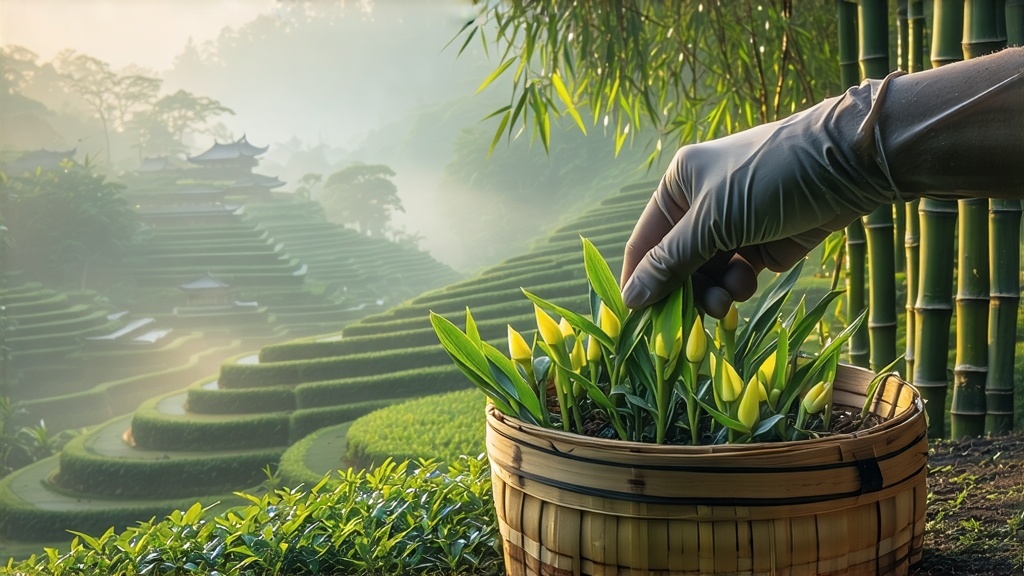
Tucked high on the northern rim of the Sichuan Basin, where the Min River carves misty corridors between 30°N latitude and 1,000-year-old Buddhist cliffs, lies Meng Ding Mountain—legendary birthplace of the world’s first cultivated tea and, more discreetly, the cradle of Meng Ding Huang Ya. Unlike the emerald flash of Dragon Well or the midnight twist of Tie Guan Yin, this yellow tea greets the eye with a muted, almost suede-like yellow-green that whispers rather than shouts. To international drinkers accustomed to the binary palette of green and black, Meng Ding Huang Ya offers a third, far rarer chroma—one born of imperial whim, monastic patience, and a microbial waltz that tea makers call “men huang,” the sealed yellowing.
Historical scrolls kept at the mountain’s Ganlu Temple record that the monk Wu Lizhen planted seven tea bushes on Meng Ding as early as 53 BCE, presenting their spring buds to Emperor Jing of Han. By the Tang dynasty (618-907 CE) the tea had become “tribute only,” carried by fast horses down narrow plank roads to Chang’an within three days of plucking. The Song Annals of Sichuan note that officials who allowed commoners to taste Meng Ding risked flogging. Yet fame waxes and wanes; when green tea’s fixation by dry wok spread eastward in the Ming, yellow tea’s slower, humidity-controlled step was nearly abandoned. Only a handful of families on the mountain’s five famous peaks—Shangqing, Lingyao, Ganlu, Tianjing, and Wanchun—kept the art alive, passing it from mother to daughter under the condition that “one must wait for the bud to speak before it is allowed to rest.”
Meng Ding Huang Ya is not a single clone but a micro-ecology of cultivars grafted onto ancient seed-stock. The most prized is the “local small-leaf yellow early,” a landrace that keeps its buds downy even after yellowing, exuding notes of fresh lychee and steamed pumpkin. Secondary gardens grow a purple-stemmed variant called “ziyaguo” whose anthocyanins soften into cocoa tones during men huang. Above 1,200 m, frost-tender “snow bud” bushes yield fewer than 300 grams of finished tea per mu, yet their amino acid load surpasses 6 %, gifting the liquor a brothy umami that rivals gyokuro.
Harvest obeys a lunar clock: plucking begins on Qingming day when the mountain azaleas bloom and ends before Grain Rain, a window of barely twenty days. Pickers climb bamboo ladders at dawn, selecting only the unopened bud or the single bud-with-one-leaf standard no longer than 2.5 cm. Leaves must be carried in open-weave rattan trays so that dawn dew can evaporate during the 40-minute trek to the village workshop; any compression would bruise the cells and turn the final tea reddish.
The craft sequence follows five immutable steps, each calibrated to relative humidity measured by a 400-year-old stone hygrometer still hanging beside the charcoal trench.
- Sha Qing (Kill-Green): 180 °C bamboo-roofed wok, 4 minutes, 1.5 kg per batch. The goal is not full de-enzyming—70 % polyphenol oxidase activity is intentionally left alive for later yellowing.
- Re Nian (Hot Rolling): immediately after wok exit, leaves are rolled under palm-fiber cloth at 60 °C for eight minutes; the slight tearing of cell walls provides substrate for non-enzymatic browning.
- Men Huang (Sealed Yellowing): the signature move. Rolled leaves are piled 8 cm deep in oak boxes lined with wet hemp, then slid into a cave-like room kept at 32 °C and 78 % RH for 48–72 hours. Every six hours the pile is gently turned to equalize micro-oxygenation; during this span chlorophyll degrades to pheophytin, catechins dimerize into theaflavins, and a faint yellow bloom—Geotrichum candida—appears on leaf edges, imparting a steamed-rice sweetness.
- Mao Huo (Primary Drying): bamboo-basket roasting over 80 °C charcoal embers reduces moisture to 20 %.